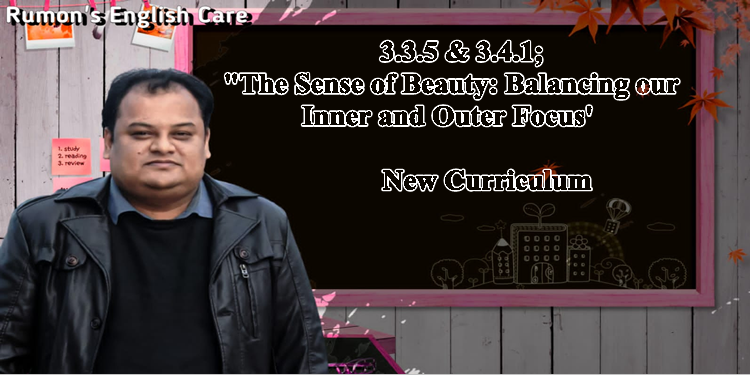3.3.5 & 3.4.1; “The Sense of Beauty: Balancing our Inner and Outer Focus’
3.3.5 Read the text “The Sense of Beauty: Balancing our Inner and Outer Focus’ again and summaries it in one paragraph. Later, do a pair check and finally share it with the whole class. ‘The Sense of Beauty: Balancing our Inner and Outer Focus’
The following guidelines are to help you write the summary.
- First, read the text attentively and identify the main ideas of the text.
- Then, list all the main ideas you have got in the text.
- Later, organize all your ideas.
- Now, write the introductory sentence of the summary.
- It’s time to turn all of your main ideas into sentences.
- Here, combine all the sentences into one paragraph. Do not forget to use connecting words/cohesive devices to make your summary meaningful.
- Now, check the use of punctuation marks, spelling, grammar, and organization of the summary, and make the necessary edits.
- Finally, write the final draft of your summary.
Summary of the text: English (Class Nine)
Answers: The text highlights the universal nature of the sense of beauty, its impact on our existence, and the appreciation of both inner virtues and external aesthetics. It also claims that while beauty is subjective, there are objective elements that evoke a sense of awe, pleasure, and inspiration in individuals. Beauty is not confined to what people see; rather, it can be found in everything. It includes both inner beauty and external aesthetics. Inner beauty lies in a pretty soul, beautiful thoughts, and beautiful literature. Inner beauty encompasses the inner qualities of a beautiful person. Inner beauty creates a lasting impact on our experience. It serves as a moral. compass for individuals and contributes to a more harmonious society. The sense of beauty enriches our emotions and imaginations, and it provides a source of inspiration. Exposure to beauty awakens our senses and evokes a sense of joy, wonder, and tranquility. The text concludes by advocating for a balance between the inner and outer realms of beauty and by fostering the sense of beauty within us as a powerful source to bring meaning to our existence.
3.4.1 Let’s be reasonable! Read the given topic and follow the instructions to participate in the debate. Follow the given instructions and take necessary help from your teachers, family, friends etc. to complete the work.
- First, identify some issues around you that need to be addressed and prepare a list of them.
- Then, think and discuss in pairs/groups to decide on one issue from the list. Choose one that you can argue on and write your topic and determine your position.
- Next, talk to the people around you to know their opinions regarding the topic and take notes to use further.
- Now, read all the arguments you have got and plan your argumentative essay. Write the introduction, and body paragraphs (2-3 your arguments and 1-2 counterarguments you got from your conversation with the people), explain the arguments and use evidence to support the arguments. Finally, write the conclusion.
- Here, edit your writing and write the final draft.
- Now, share it with the class. Also, you may publish it in your school magazine or any newspaper to draw the attention of the concerned authority.
Let us know what free education is first.
Free education refers to a system of education where education is provided without the imposition of direct costs or fees on students. In a system of free education, individuals are not charged tuition or other charges for sitting in an educational institution. This system can apply to various levels of education, including primary, secondary, and higher education. Free educational doesn’t mean that education is free altogether. Rather, government or charity organizations come to fund education.
Opening statements from the group that supports free education:
Free education means that any child, no matter where they come from, will be able to get the same quality education. Free education at certain level is constitution right. Free education is important because it guarantees some level of education for every student in the country. This means that every student has an equal opportunity to reach this level of education at an equal level. Individuals have significant barriers to education, including tuition fees, textbooks, and other related expenses. Free education allows more people to pursue education, eliminating financial barriers to education. Thus the literacy rate of country is increased. For the development of the country, a more well-educated population is needed. Free education contributes to generating a more skilled and educated workforce. Free education allows disadvantaged people to break the cycle of poverty and improve their socioeconomic status. In addition, students will not be worried about getting student loans to facilitate their education. This ensures that students remain debt-free.
Opening statements from the group that opposes free education:
I think free education creates a number of distortions. Thought free education is free for students, but government has to bear such huge expenses. This means that free education forces the government to borrow money for free education in the country and to raise government taxes. Low quality education will arise as educational institutions might face budget limitations. Therefore, this limitation leads to a lower quality of education and reduces overall educational standards. Free education discourages youth from dealing with money in a responsible way that can make them green in managing money. Free education makes the students less serious; on the other hand, paying for education serves as a motivator for students to take their studies seriously. Free education means that there will be overcrowded classrooms, which will negatively affect the personal touch required between teacher and student
New Words: speech, profound, satisfaction, remarkable, inequalities, aggression, wildlife, initiatives, poaching, monumental, envisioned, encompasses.
বক্তৃতা, গভীর, সন্তুষ্টি, উল্লেখযোগ্য, অসমতা, আগ্রাসন, বন্যপ্রাণী, উদ্যোগ, শিকার, স্মৃতিবিজড়িত, কল্পনা করা, অন্তর্ভুক্ত।

